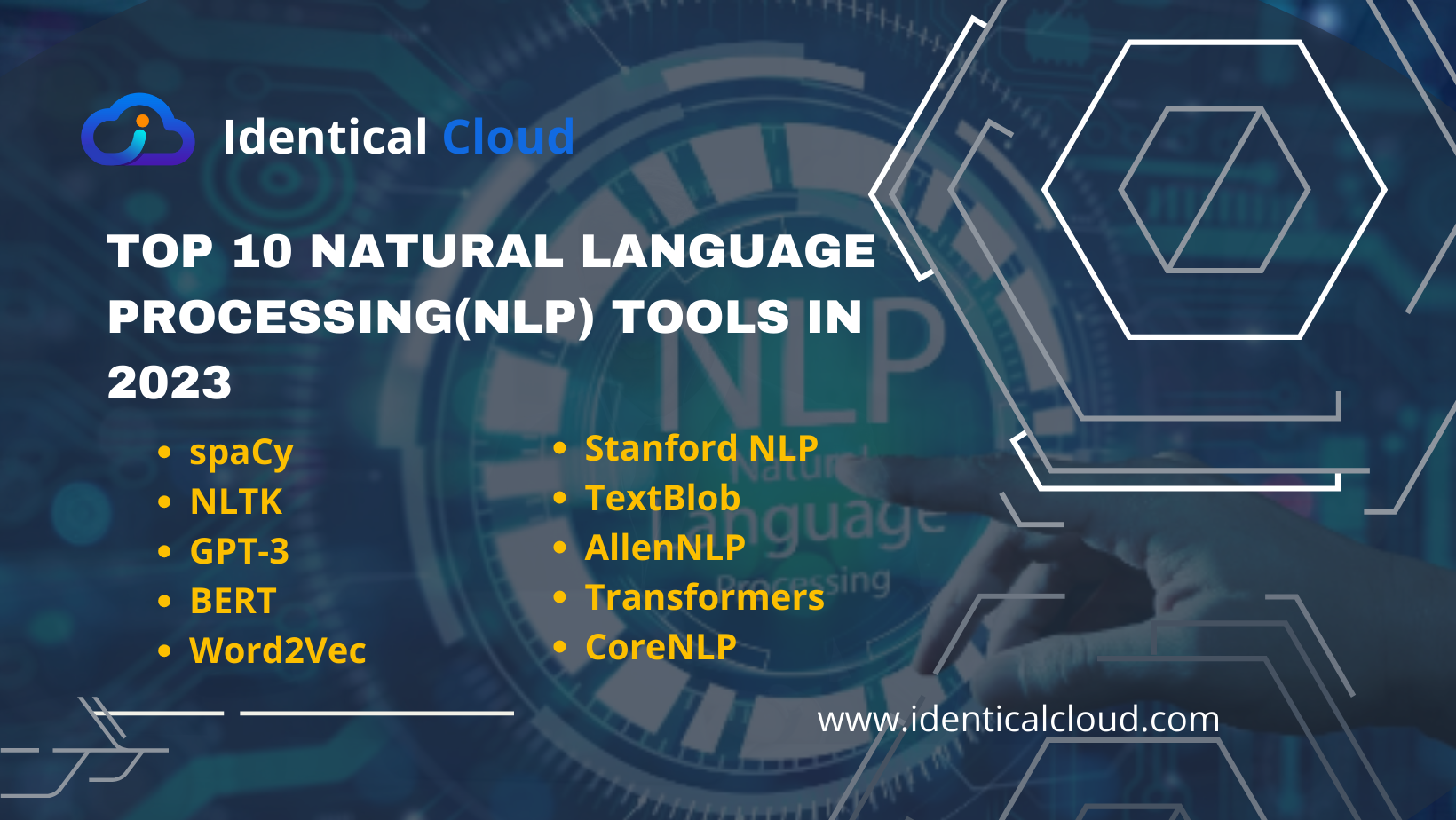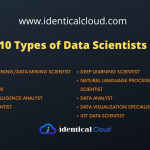
Top 10 Natural Language Processing(NLP) Tools in 2023
Top 10 Natural Language Processing(NLP) Tools in 2023
In the realm of Artificial Intelligence (AI), one domain stands out for its transformative impact on human-computer interaction and communication: Natural Language Processing (NLP). NLP has evolved from a niche field to a driving force that underpins various applications, from chatbots and language translation to sentiment analysis and content generation. As we step into 2023, this blog unveils the top 10 NLP tools that are shaping the landscape of language-driven AI, providing developers, researchers, and businesses with the arsenal they need to decode and utilize the nuances of human language.
1. spaCy:
spaCy is a popular open-source NLP library known for its speed and efficiency in text processing. It offers pre-trained models for various languages, enabling tasks such as part-of-speech tagging, named entity recognition, and dependency parsing.
spaCy’s standout feature lies in its efficiency. Built with the goal of being the fastest NLP library, spaCy processes text at an impressive speed, making it a preferred choice for applications where real-time or large-scale processing is crucial. Its pre-trained statistical models cover various languages and tasks, from tokenization and part-of-speech tagging to named entity recognition and dependency parsing.
Despite its advanced capabilities, spaCy is designed with simplicity in mind. Its user-friendly API allows developers to integrate NLP functionalities seamlessly into their applications. Whether you’re a seasoned NLP practitioner or a newcomer to the field, spaCy’s intuitive interface streamlines the process of text processing, reducing the learning curve and boosting productivity.
Key Features:
- Tokenization: spaCy excels in tokenization, breaking text into words, phrases, or sentences, a crucial initial step for various NLP tasks.
- Part-of-Speech Tagging: The library’s accurate part-of-speech tagging assigns grammatical categories to words, aiding in syntactic analysis and understanding text structure.
- Named Entity Recognition: spaCy’s named entity recognition capabilities identify entities such as names, locations, and dates, enriching information extraction and knowledge discovery.
- Dependency Parsing: The library’s dependency parsing analyzes the grammatical relationships between words, offering insights into the structure and semantics of sentences.
An open-source tool thrives on its community, and spaCy’s community is vibrant and collaborative. With an active user base, ongoing development, and regular updates, spaCy continues to evolve, addressing emerging needs and staying at the forefront of NLP advancements.
2. NLTK (Natural Language Toolkit):
NLTK is a comprehensive library that serves as a foundation for NLP research and development. It provides a wide range of tools for tasks like tokenization, stemming, sentiment analysis, and more.
NLTK serves as a cornerstone in the NLP landscape. Designed to facilitate the understanding and manipulation of human language data, NLTK equips users with tools to process text, extract insights, and build language models. Its robustness and versatility make it an essential companion for various stages of NLP research, from data preprocessing to advanced linguistic analysis.
Key Features:
- Text Processing: NLTK offers a plethora of functions for text processing, including tokenization (breaking text into words or sentences), stemming (reducing words to their root form), and lemmatization (reducing words to their base or dictionary form).
- Language Resources: The toolkit provides access to diverse language resources, including corpora (collections of text for linguistic analysis) and lexicons (dictionaries of words and their meanings).
- Part-of-Speech Tagging: NLTK’s part-of-speech tagging assigns grammatical categories to words in a text, enabling syntactic analysis and language understanding.
- Named Entity Recognition: NLTK’s named entity recognition identifies entities such as names of people, organizations, and locations within a text.
- Sentiment Analysis: The library facilitates sentiment analysis by allowing users to classify text based on its emotional tone, a valuable feature for understanding public opinion and social trends.
- Machine Learning Integration: NLTK seamlessly integrates machine learning algorithms for tasks like text classification, clustering, and language generation.
One of NLTK’s distinguishing features is its commitment to education. Beyond being a practical toolkit, NLTK offers learning resources, tutorials, and documentation that cater to both newcomers and experienced practitioners. Its user-friendly interface encourages hands-on exploration, enabling users to grasp complex NLP concepts and techniques.
NLTK’s strength lies in its active and vibrant community. Contributors, developers, and linguists collaborate to enhance the toolkit’s capabilities, add language resources, and adapt to evolving NLP trends.
3. GPT-3 (Generative Pre-trained Transformer 3):
GPT-3, developed by OpenAI, is a state-of-the-art language model that has captured global attention. It excels in tasks like text completion, language generation, and even code writing, showcasing the power of large-scale language models.
GPT-3 represents a significant leap forward in language modeling. It is the third iteration of OpenAI’s “Generative Pre-trained Transformer” series, and it builds upon the foundation laid by its predecessors. GPT-3 employs a transformer architecture, a neural network structure that excels in sequence-to-sequence tasks, making it highly adept at handling language generation, translation, and understanding.
Key Features:
- Unprecedented Scale: GPT-3 boasts a staggering 175 billion parameters, making it one of the largest language models ever created. This immense scale allows it to capture intricate nuances of human language and produce coherent and contextually relevant text.
- Few-Shot and Zero-Shot Learning: One of GPT-3’s standout features is its ability to perform tasks with minimal or even zero examples. This means that, given a task description or prompt, GPT-3 can generate accurate and relevant responses, even for tasks it wasn’t explicitly trained on.
- Language Translation: GPT-3 showcases remarkable language translation capabilities, effortlessly converting text from one language to another while preserving meaning and context.
- Text Completion and Generation: GPT-3 excels in generating creative and coherent text, whether it’s completing sentences, writing stories, or even crafting code snippets.
- Question Answering: The model can comprehend and answer questions posed in natural language, demonstrating an understanding of context and information retrieval.
- Conversational AI: GPT-3 can simulate human-like conversation, engaging in dialogues that feel remarkably natural and responsive.
While GPT-3’s capabilities are awe-inspiring, they also raise ethical concerns. The model’s potential to generate fake news, biased content, or misleading information highlights the importance of responsible use and vigilant oversight.
4. BERT (Bidirectional Encoder Representations from Transformers):
BERT, another creation from Google AI, revolutionized NLP with its bidirectional context understanding. It has significantly advanced tasks like sentiment analysis, question answering, and text classification.
Key Features:
- Bidirectional Attention: BERT’s bidirectional attention mechanism enables it to consider both preceding and succeeding words when processing a given word. This comprehensive understanding of context results in more accurate language understanding.
- Pre-training and Fine-tuning: BERT is pre-trained on a large corpus of text data, which equips it with a deep understanding of language. Fine-tuning the pre-trained model on specific tasks allows it to adapt and excel in various NLP applications.
- Transformers Architecture: BERT employs the transformer architecture, which has proven highly effective in capturing long-range dependencies in sequences. The self-attention mechanism in transformers contributes to BERT’s ability to process context effectively.
- Variants and Sizes: BERT comes in various sizes, from smaller versions that are efficient for deployment on edge devices to larger versions that offer enhanced performance and accuracy.
Since its introduction, BERT has sparked a wave of advancements in NLP. Researchers and developers have built upon BERT’s foundations, creating variations like RoBERTa, ALBERT, and more, which further refine contextualized language understanding and performance.
While BERT’s contextualization significantly improves language understanding, it also brings challenges, such as model complexity, resource requirements, and fine-tuning complexities. Ensuring that BERT-based models are used responsibly to mitigate biases and produce accurate results remains a crucial consideration.
5. Word2Vec:
Word2Vec, developed by Google, introduced the concept of word embeddings. It represents words as vectors, capturing semantic relationships between them. This technology has found applications in various NLP tasks.
At its core, Word2Vec is a methodology for transforming words into high-dimensional vectors. These vectors capture the contextual relationships between words, enabling machines to interpret semantic similarities and differences. Word2Vec operates on the principle that words appearing in similar contexts are likely to have similar meanings.
Key Concepts:
- Continuous Bag of Words (CBOW): CBOW is one of the architectures used in Word2Vec. It predicts a target word based on its neighboring context words. CBOW is efficient and well-suited for training on large corpora.
- Skip-gram: Skip-gram is another architecture within Word2Vec. It predicts context words based on a target word. While computationally more intensive than CBOW, skip-gram often performs better with a smaller amount of training data.
- Vector Space Mapping: Word2Vec transforms words into dense, continuous vectors in a high-dimensional space. These vectors capture semantic relationships, allowing mathematical operations like addition and subtraction to convey word analogies.
Limitations and Considerations:
While Word2Vec offers transformative capabilities, it has certain limitations:
- Out-of-Vocabulary Words: Words not encountered during training can pose a challenge for Word2Vec’s vectorization.
- Context Window: Word2Vec’s performance heavily depends on the context window size, which determines the range of neighboring words considered.
- Polysemy Handling: While Word2Vec improves polysemy handling, disambiguating all instances of polysemous words remains a challenge.
Word2Vec laid the foundation for subsequent innovations, inspiring models like GloVe (Global Vectors for Word Representation) and fastText. These models refine the process of word vectorization and semantic understanding.
6. Stanford NLP:
Stanford NLP offers a suite of tools for tasks like tokenization, part-of-speech tagging, and named entity recognition. Its robustness and accuracy make it a go-to choice for many researchers and developers.
Stanford NLP embodies the spirit of academic rigor and cutting-edge research. Crafted by a team of experts, the toolkit embodies decades of linguistic knowledge and computational expertise, offering a suite of tools that cater to a wide spectrum of NLP tasks.
Key Features:
- Robust Linguistic Analysis: Stanford NLP offers a plethora of tools for comprehensive linguistic analysis, including tokenization, part-of-speech tagging, named entity recognition, dependency parsing, and coreference resolution.
- Pre-trained Models: The toolkit provides pre-trained models that cover multiple languages, enabling accurate and context-aware analysis for diverse text inputs.
- Customization: While offering pre-trained models, Stanford NLP also allows users to train custom models on domain-specific data, tailoring the toolkit to specific applications and industries.
- Coreference Resolution: Stanford NLP’s coreference resolution capabilities identify relationships between mentions of entities within a text, contributing to a deeper understanding of text coherence.
Stanford NLP thrives on collaboration and knowledge sharing. It embodies the ethos of open-source software, inviting contributions from the NLP community to enhance its features, expand language support, and improve performance.
Considerations and Challenges:
While Stanford NLP offers a wealth of linguistic insights, it also presents certain challenges:
- Resource Intensity: Some advanced tasks, like deep parsing, can be resource-intensive, requiring significant computational power and memory.
- Learning Curve: Utilizing Stanford NLP to its full potential may require users to familiarize themselves with linguistic concepts and NLP techniques.
As the field of NLP evolves, Stanford NLP remains a stalwart companion for those seeking in-depth linguistic analysis and understanding. Its commitment to linguistic excellence and open-source collaboration ensures that it remains at the forefront of NLP advancements, enriching the world of AI with insights into the intricate tapestry of human language.
7. TextBlob:
TextBlob is a simple and user-friendly library built on top of NLTK and Pattern. It offers a range of NLP tasks, including sentiment analysis, translation, and part-of-speech tagging, with a straightforward API.
TextBlob is designed with simplicity in mind. It serves as a friendly entry point for those new to NLP, providing a seamless interface for text processing without requiring an in-depth understanding of complex algorithms.
Key Features:
- Basic Text Processing: TextBlob offers fundamental text processing functionalities, such as tokenization (breaking text into words or sentences), part-of-speech tagging (assigning grammatical categories to words), and noun phrase extraction.
- Sentiment Analysis: One of TextBlob’s standout features is sentiment analysis. It evaluates the emotional tone of text, assigning positive, negative, or neutral sentiments to sentences or documents.
- Language Translation: TextBlob supports language translation, allowing users to translate text between different languages, enhancing cross-lingual communication.
- Noun Phrase Extraction: The library identifies noun phrases within text, aiding in content categorization and semantic understanding.
- Spelling Correction: TextBlob can correct spelling errors, enhancing the accuracy of text analysis and comprehension.
TextBlob’s user-friendly design extends to its extensibility. It allows users to add custom classifiers, part-of-speech taggers, and sentiment analysis models, tailoring the library to specific needs.
While TextBlob excels in simplicity, it may not provide the same level of fine-tuned accuracy as more advanced NLP frameworks. Complex NLP tasks requiring deep linguistic analysis might benefit from more specialized tools.
TextBlob thrives on community collaboration. Users contribute to its development, continuously expanding its capabilities and improving its performance.
TextBlob’s role in NLP is not just about simplicity; it’s about democratizing text analysis. As AI and NLP become increasingly integral to our digital interactions, TextBlob empowers a broader audience to harness the potential of language-driven insights.
8. AllenNLP:
AllenNLP is designed for deep learning-based NLP research. It provides a platform to build and evaluate models for tasks like text classification, semantic role labeling, and text generation.
At its core, AllenNLP is a deep learning framework that simplifies the process of designing, training, and evaluating complex NLP models. It provides a high-level interface for researchers to focus on model architecture and experimentation rather than low-level implementation details.
Key Features:
- Modularity and Customization: AllenNLP’s modular architecture allows users to combine pre-built components or create custom ones, enabling the creation of diverse NLP models tailored to specific tasks.
- Flexibility in Experimentation: Researchers can easily experiment with new model architectures, loss functions, and evaluation metrics, fostering a culture of innovation and exploration.
- Pre-trained Models: AllenNLP offers access to a variety of pre-trained models, such as BERT and GPT, enabling users to leverage the power of transfer learning for improved performance.
- Natural Language Understanding Tasks: The toolkit supports a wide range of NLP tasks, including text classification, sequence tagging, language generation, machine translation, and more.
While AllenNLP empowers researchers and developers, it may require a familiarity with deep learning concepts and NLP fundamentals for effective use. Additionally, training and fine-tuning complex models can be resource-intensive.
As the NLP field evolves, AllenNLP remains at the forefront of innovation. Its combination of flexibility, modularity, and deep learning expertise makes it an invaluable asset in advancing the frontiers of language-driven AI.
9. Transformers:
Transformers is a library developed by Hugging Face that offers a wide range of pre-trained models for tasks like text generation, translation, and summarization. It has gained popularity for its user-friendly APIs and extensive model support.
At the heart of transformers lies a groundbreaking architectural design that prioritizes attention mechanisms and parallel processing. Unlike traditional sequential models, transformers process words in parallel, enabling efficient training and inference on large-scale data.
Key Components:
- Self-Attention: Transformers leverage self-attention mechanisms to weigh the importance of different words in a sequence when processing a specific word. This enables capturing long-range dependencies and contextual relationships.
- Multi-Head Attention: Multi-head attention allows transformers to focus on different aspects of the input sequence simultaneously, enhancing their ability to learn complex patterns.
- Positional Encoding: Since transformers process words in parallel, they lack inherent understanding of word positions. Positional encoding is added to input embeddings to provide the model with positional information.
- Encoder and Decoder Stacks: Transformers often consist of encoder and decoder stacks. The encoder processes input data, while the decoder generates output sequences, making transformers suitable for tasks like machine translation and language generation.
Challenges and Considerations:
While transformers have propelled NLP to new heights, they are not without challenges:
- Resource Intensive: Training large transformer models can be computationally demanding and resource-intensive.
- Fine-Tuning Complexity: Fine-tuning transformers for specific tasks requires domain expertise and careful parameter tuning.
Transformers have redefined the AI landscape, transcending language tasks to impact computer vision, speech recognition, and more. Their architectural elegance and remarkable performance have spurred research, innovation, and new breakthroughs.
10. CoreNLP:
CoreNLP is developed by Stanford University and provides tools for core NLP tasks, including part-of-speech tagging, dependency parsing, and sentiment analysis. It supports multiple languages and is available in various programming languages.
Key Features:
- Linguistic Analysis: CoreNLP offers a suite of linguistic analysis tools, including tokenization, part-of-speech tagging, named entity recognition, dependency parsing, coreference resolution, and more.
- Extensive Language Support: The toolkit supports a wide range of languages, making it versatile and adaptable to multilingual applications.
- Customizable Pipelines: CoreNLP allows users to create customized processing pipelines by combining various linguistic annotations, tailoring the toolkit to specific tasks and domains.
- Pre-trained Models: CoreNLP provides pre-trained models that encapsulate linguistic knowledge and enable accurate and context-aware analysis.
While CoreNLP offers an extensive range of tools, it may require users to have a foundational understanding of linguistic concepts and NLP techniques. Processing large volumes of text with extensive linguistic analysis can also be resource-intensive.
CoreNLP thrives on community collaboration, with users contributing to its development, expanding its language support, and refining its capabilities.
As NLP continues to advance, CoreNLP remains a cornerstone of linguistic analysis. Its combination of linguistic rigor, computational prowess, and community-driven development ensures its place at the forefront of language-driven AI.
Natural Language Processing is a realm that continues to evolve, offering endless possibilities for understanding and interacting with human language. The top 10 NLP tools of 2023 exemplify the strides made in this field, providing both beginners and experts with the tools to unravel the complexities of language, from sentiment and semantics to syntax and beyond. As we move forward, these tools will play an integral role in shaping the AI landscape, enabling innovations that bridge the gap between human communication and machine understanding.







